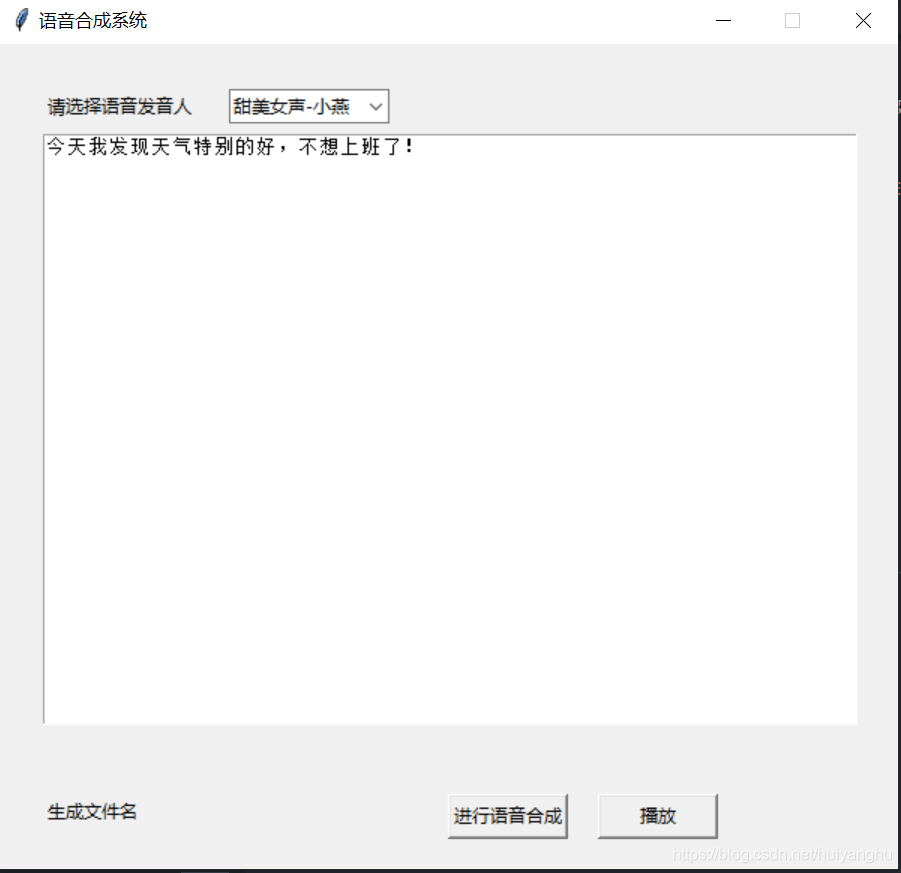您好,登錄后才能下訂單哦!
您好,登錄后才能下訂單哦!
這篇文章主要介紹了基于Python怎么編寫一個語音合成系統的相關知識,內容詳細易懂,操作簡單快捷,具有一定借鑒價值,相信大家閱讀完這篇基于Python怎么編寫一個語音合成系統文章都會有所收獲,下面我們一起來看看吧。
一直對語音合成系統比較感興趣,總想能給自己合成一點內容,比如說合成小說,把我下載的電子書播報給我聽等等。
其實就是一個基于語音合成的工具,但是這個東西由于很多廠家都提供了API的形式,因此開發難度大大降低,只需要調用幾個API即可實現屬于自己的語音合成工具;麻雀雖小,五臟俱全。往大了說,這就是一個小型的語音合成系統。
首先我們電腦上需要安裝
Anaconda
Python 3.7
visual studio code
這里我們選用訊飛開放平臺的WebAPI接口。
首先我們到控制臺創建一個應用

創建好了之后,點擊該應用進入,有該應用的詳細欄目。
點擊左側的語音合成,再到下一級在線語音合成(流式版)

在右上側,我們需要拿到3個東西:
APPID
APISecret
APIKey
好了接下來進行代碼實現了,首先安裝我們需要的兩個庫。
pip install websocket-client pip install playsound
接下來我們定義一個類play,包含4個函數
class play: def __init__(self): #初始化函數 def play_sound(self):#播放音頻函數 def select_vcn(self,*arg):#選擇下拉框設置發音人 def xfyun_tts(self):#進行語音合成
在這里,大家需要填上剛才從訊飛開放平臺控制臺獲取到的appid、appkey以及appsecret
def __init__(self):
self.APP_ID = 'xxx' #請填上自己的appid
self.API_KEY = 'xxx' #請填上自己的appkey
self.SECRET_KEY = 'xxx' #請填上自己的appsecret
self.root=tk.Tk() #初始化窗口
self.root.title("語音合成系統") #窗口名稱
self.root.geometry("600x550") #設置窗口大小
self.root.resizable(0,0)
#self.root.resizable(width=True,height=True)#設置窗口是否可變,寬不可變,高可變,默認為True
self.lb=tk.Label(self.root,text='請選擇語音發音人')#標簽
self.tt=tk.Text(self.root,width=77,height=30) #多行文本框
self.cb=ttk.Combobox(self.root, width=12) #下拉列表框
#設置下拉列表框的內容
self.cb['values']=("甜美女聲-小燕","親切男聲-許久","知性女聲-小萍", "可愛童聲-許小寶","親切女聲-小婧")
self.cb.current(0) #將當前選擇狀態置為0,也就是第一項
self.cb.bind("<<ComboboxSelected>>", self.select_vcn)
self.tk_tts_file=tk.Label(self.root,text='生成文件名')
self.b1=tk.Button(self.root, text='進行語音合成', width=10,height=1,command=self.xfyun_tts) #按鈕
self.tk_play=tk.Button(self.root, text='播放', width=10,height=1,command=self.play_sound) #按鈕
#各個組件的位置
self.tk_tts_file.place(x=30,y=500)
self.b1.place(x=300,y=500)
self.tk_play.place(x=400,y=500)
self.lb.place(x=30,y=30)
self.cb.place(x=154,y=30)
self.tt.place(x=30,y=60)
self.root.mainloop()當選擇了下拉列表,設置對應的發音人
def select_vcn(self,*arg): if self.cb.get()=='甜美女聲-小燕': self.vcn="xiaoyan" elif self.cb.get()=='親切男聲-許久': self.vcn="aisjiuxu" elif self.cb.get()=='知性女聲-小萍': self.vcn="aisxping" elif self.cb.get()=='可愛童聲-許小寶': self.vcn="aisbabyxu" elif self.cb.get()=='親切女聲-小婧': self.vcn="aisjinger" print(self.vcn)
接下來我們來魔改訊飛自帶的Python demo為從而更加方便的來使用
# -*- coding:utf-8 -*-
#
# author: iflytek
#
# 本demo測試時運行的環境為:Windows + Python3.7
# 本demo測試成功運行時所安裝的第三方庫及其版本如下:
# cffi==1.12.3
# gevent==1.4.0
# greenlet==0.4.15
# pycparser==2.19
# six==1.12.0
# websocket==0.2.1
# websocket-client==0.56.0
# 合成小語種需要傳輸小語種文本、使用小語種發音人vcn、tte=unicode以及修改文本編碼方式
# 錯誤碼鏈接:https://www.xfyun.cn/document/error-code (code返回錯誤碼時必看)
# # # # # # # # # # # # # # # # # # # # # # # # # # # # # # # # # # # # # # # # # # # # # # # # # # # # # # # # # # # #
import websocket
import datetime
import hashlib
import base64
import hmac
import json
from urllib.parse import urlencode
import time
import ssl
from wsgiref.handlers import format_date_time
from datetime import datetime
from time import mktime
import _thread as thread
import os
import wave
STATUS_FIRST_FRAME = 0 # 第一幀的標識
STATUS_CONTINUE_FRAME = 1 # 中間幀標識
STATUS_LAST_FRAME = 2 # 最后一幀的標識
PCM_PATH = "./demo.pcm"
class Ws_Param(object):
# 初始化
def __init__(self):
pass
def set_tts_params(self, text, vcn):
if text != "":
self.Text = text
if vcn != "":
self.vcn = vcn
# 業務參數(business),更多個性化參數可在官網查看
self.BusinessArgs = {"bgs":1,"aue": "raw", "auf": "audio/L16;rate=16000", "vcn": self.vcn, "tte": "utf8"}
#使用小語種須使用以下方式,此處的unicode指的是 utf16小端的編碼方式,即"UTF-16LE"”
#self.Data = {"status": 2, "text": str(base64.b64encode(self.Text.encode('utf-16')), "UTF8")}
self.Data = {"status": 2, "text": str(base64.b64encode(self.Text.encode('utf-8')), "UTF8")}
def set_params(self, appid, apiSecret, apiKey):
if appid != "":
self.APPID = appid
# 公共參數(common)
self.CommonArgs = {"app_id": self.APPID}
if apiKey != "":
self.APIKey = apiKey
if apiSecret != "":
self.APISecret = apiSecret
# 生成url
def create_url(self):
url = 'wss://tts-api.xfyun.cn/v2/tts'
# 生成RFC1123格式的時間戳
now = datetime.now()
date = format_date_time(mktime(now.timetuple()))
# 拼接字符串
signature_origin = "host: " + "ws-api.xfyun.cn" + "\n"
signature_origin += "date: " + date + "\n"
signature_origin += "GET " + "/v2/tts " + "HTTP/1.1"
# 進行hmac-sha256進行加密
signature_sha = hmac.new(self.APISecret.encode('utf-8'), signature_origin.encode('utf-8'),
digestmod=hashlib.sha256).digest()
signature_sha = base64.b64encode(signature_sha).decode(encoding='utf-8')
authorization_origin = "api_key=\"%s\", algorithm=\"%s\", headers=\"%s\", signature=\"%s\"" % (
self.APIKey, "hmac-sha256", "host date request-line", signature_sha)
authorization = base64.b64encode(authorization_origin.encode('utf-8')).decode(encoding='utf-8')
# 將請求的鑒權參數組合為字典
v = {
"authorization": authorization,
"date": date,
"host": "ws-api.xfyun.cn"
}
url = url + '?' + urlencode(v)
return url
def on_message(ws, message):
try:
#print(message)
try:
message =json.loads(message)
except Exception as e:
print("111",e)
code = message["code"]
sid = message["sid"]
audio = message["data"]["audio"]
audio = base64.b64decode(audio)
status = message["data"]["status"]
print(code, sid, status)
if status == 2:
print("ws is closed")
ws.close()
if code != 0:
errMsg = message["message"]
print("sid:%s call error:%s code is:%s" % (sid, errMsg, code))
else:
with open(PCM_PATH, 'ab') as f:
f.write(audio)
except Exception as e:
print("receive msg,but parse exception:", e)
# 收到websocket錯誤的處理
def on_error(ws, error):
print("### error:", error)
# 收到websocket關閉的處理
def on_close(ws):
print("### closed ###")
# 收到websocket連接建立的處理
def on_open(ws):
def run(*args):
d = {"common": wsParam.CommonArgs,
"business": wsParam.BusinessArgs,
"data": wsParam.Data,
}
d = json.dumps(d)
print("------>開始發送文本數據")
ws.send(d)
if os.path.exists(PCM_PATH):
os.remove(PCM_PATH)
thread.start_new_thread(run, ())
def text2pcm(appid, apiSecret, apiKey, text, vcn, fname):
wsParam.set_params(appid, apiSecret, apiKey)
wsParam.set_tts_params(text, vcn)
websocket.enableTrace(False)
wsUrl = wsParam.create_url()
ws = websocket.WebSocketApp(wsUrl, on_message=on_message, on_error=on_error, on_close=on_close)
ws.on_open = on_open
ws.run_forever(sslopt={"cert_reqs": ssl.CERT_NONE})
pcm2wav(PCM_PATH, fname)
def pcm2wav(fname, dstname):
with open(fname, 'rb') as pcmfile:
pcmdata = pcmfile.read()
print(len(pcmdata))
with wave.open(dstname, "wb") as wavfile:
wavfile.setparams((1, 2, 16000, 0, 'NONE', 'NONE'))
wavfile.writeframes(pcmdata)
wsParam = Ws_Param()最終一個語音合成系統就這樣實現了。

關于“基于Python怎么編寫一個語音合成系統”這篇文章的內容就介紹到這里,感謝各位的閱讀!相信大家對“基于Python怎么編寫一個語音合成系統”知識都有一定的了解,大家如果還想學習更多知識,歡迎關注億速云行業資訊頻道。
免責聲明:本站發布的內容(圖片、視頻和文字)以原創、轉載和分享為主,文章觀點不代表本網站立場,如果涉及侵權請聯系站長郵箱:is@yisu.com進行舉報,并提供相關證據,一經查實,將立刻刪除涉嫌侵權內容。